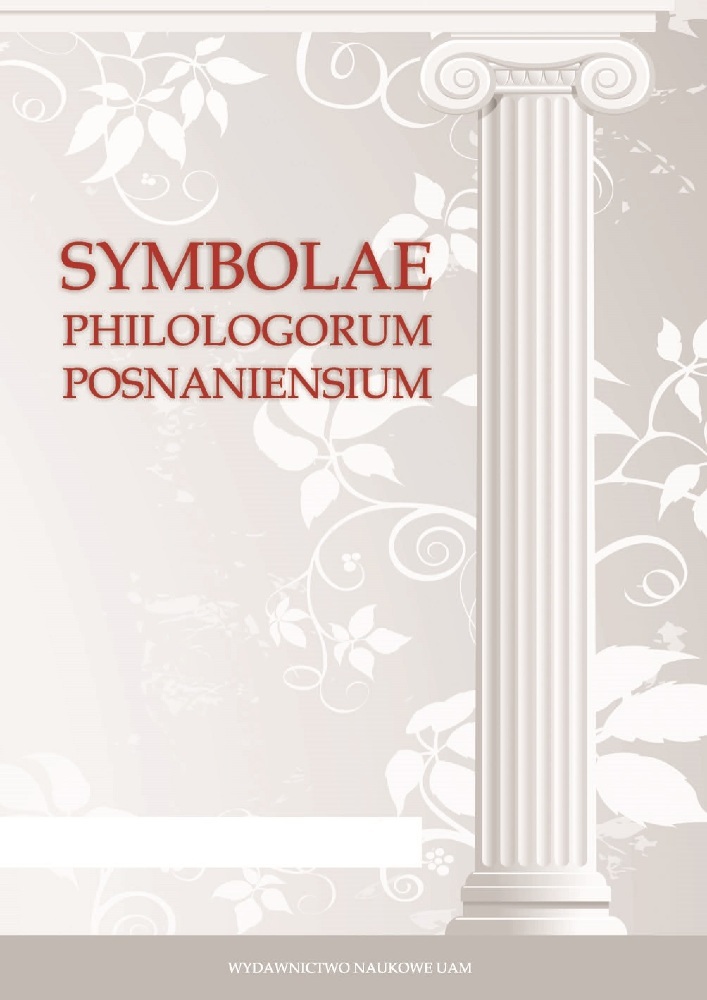Abstract
The paper studies selected aspects of the reception of Homeric theme of Nestor’s cup in the early modern times, both in emblematics and in literary worksThe longevity of king of Pylos and his oratorical skills were often alluded to in the Greek and Latin literature. As it turns out, the interpretation of the cup’s adornments included in Athenaeus’ Banquet of the Learned was widely discussed in the early modern times. This interpretation contributed both to the study of emblematics and literary works. The Homeric theme left its indelible mark also on the Old Polish literature, as in the funeral oration in honor of Bishop of Cracow Jakub Zadzik entitled Nestor Sarmaticus written by Jan Cynerski-Rachtamowicz.
References
Primary sources
Alciati 1621: Alciati, A. 1621. Emblemata. Patavii: apud Petrum Paulum Tozzium.
Athenaeus 1583: Athenaeus 1583. Athenaei Naucratitae Deipnosophistarum Libri Quindecim in Latinum Sermonem versi a Iacobo Dalechampio. Lugduni: apud Antonium de Harsy.
Cynerski-Rachtamowicz 1642: Cynerski-Rachtamowicz, J. 1642. Nestor Sarmaticus, pullato Syrmate involutus [...] a M. Joanne Cynerski Rachtamovio, Cracoviae: In officina Francisci Caesarii.
Erasmus 1998: Erasmus, D. 1998. Opera omnia Erasmi Roterodami ordinis secundi tomus secundus. Ed. by M. Laetitia van Poll-van de Lisdonk, and M. Cytowska. Amsterdam: Elsevier.
Gesner 1555: Gesner, C. 1555. Conradi Gesneri …Historiae animalium liber III qui est de Avium natura. Tiguri: apud Christophum Froschoverum.
Homer 1988: Homer. 1988. The Iliad. Vol. II. Transl. by A.T. Murray. London: William Heinemann Ltd.
Martial 1920: Martial. 1920. Epigrams. Vol. II. Transl. by W.C.A. Ker. London: William Heinemann Ltd and New York: G.P. Putnam’s Sons.
Okolski 1641: Okolski, Sz. 1641. Orbis Polonus, Splendoribus caeli: Triumphis mundi: Pulchritudine animantium: Decore aquatilium: Naturae excellentia reptilium condecoratus. Vol. I. Cracoviae: Officina Francisci Caesarii.
Ovid 1959: Ovid. 1959. Transl. by J.G. Frazer. London: William Heinemann Ltd.
Secondary sources
Bancroft-Marcus 2000: Bancroft-Marcus, R. 2000. A Dainty Dish To Set Before a King. Natale De’ Conti’s Translation of Athenaeus’ Deipnosophistae in: Athenaeus and His World: Reading Greek Culture in the Roman Empire. Ed. by D Braund and J. Wilkins. Exeter: University of Exeter Press.
Dickson 1995: Dickson, K. 1955. Nestor: Poetic Memory in Greek Epic. New York: Garland Publishing.
Erber 1998: Erber, Cz. 1998. “Wokół postaci Jakuba Zadzika (1582–1642). Część I. Autorzy utworów panegirycznych.” Kieleckie Studia Bibliologiczne 4, 9–21.
Fantuzzi, Hunter 2004: Fantuzzi, M., R. Hunter. 2004. Tradition and Innovation in Hellenistic Poetry. Cambridge: Cambridge University Press.
Knudsen 2014: Knudsen, R. A. 2014. Homeric Speech and the Origins of Rhetoric. Baltimore: Johns Hopkins University Press.
Komasara 1982: Komasara, I. 1982. Jan III Sobieski miłośnik ksiąg, Wrocław: Ossolineum.
Węcowski 2011: Węcowski, M. 2011. Sympozjon, czyli wspólne picie. Początki greckiej biesiady arystokratycznej (IX-VII wiek p.n.e.). Warszawa: Wydawnictwo Naukowe Sub Lupa.
License
